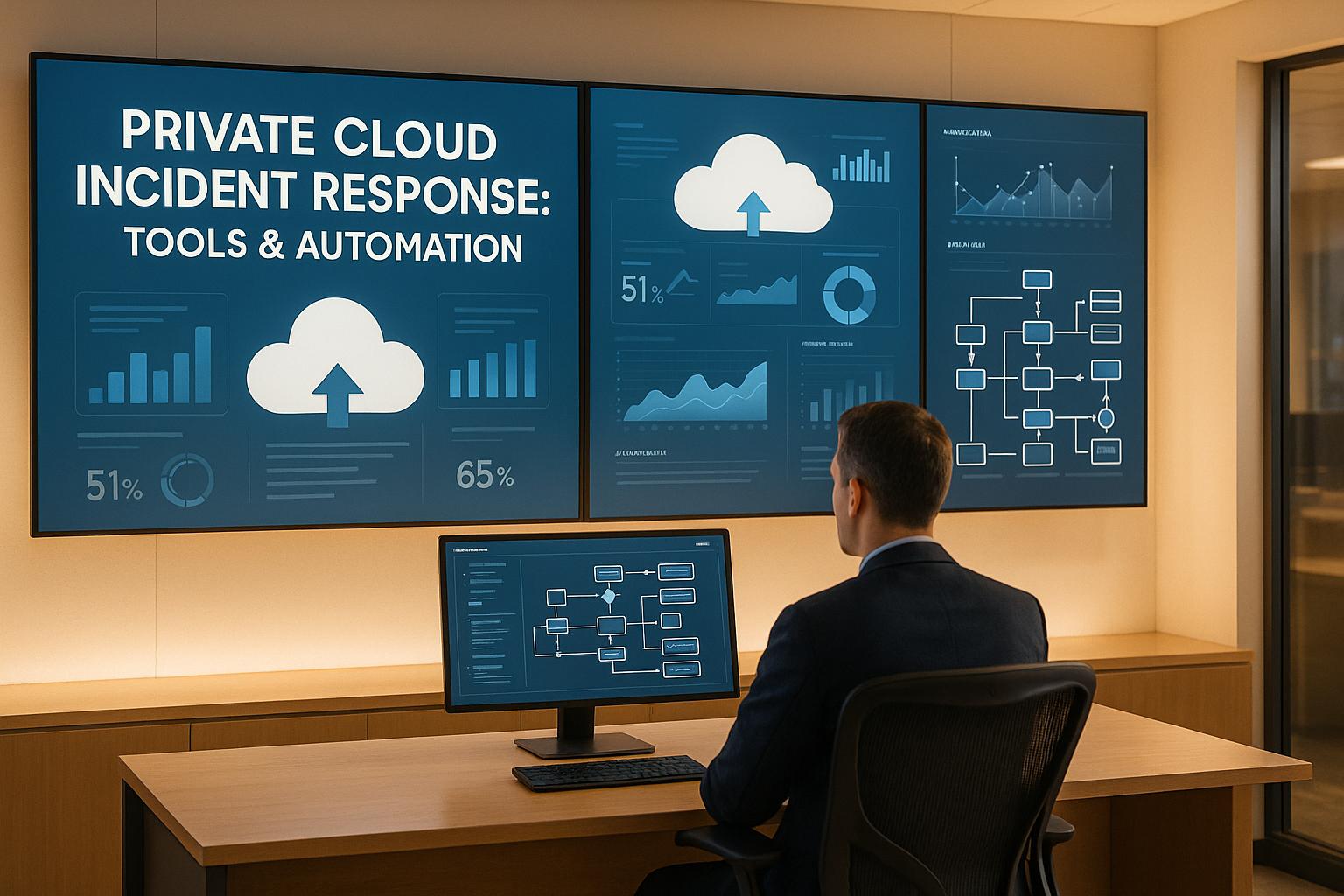Private cloud environments demand advanced incident response tools to address unique security challenges. Unlike public clouds, private setups require organisations to manage the entire security stack, making automation and effective tools critical. Automated systems can reduce incident response times by 33%, cut costs by up to £380,000 per breach, and improve service uptime to 99.5%. Here's a quick overview of leading tools:
- Sumo Logic Cloud SOAR: Automates triage, investigation, and remediation with customisable playbooks and UK data residency options.
- Wiz CIRA: Uses machine learning for real-time threat detection and compliance reporting aligned with UK regulations.
- Palo Alto Cortex XSOAR: Offers pre-built playbooks and integrates with private cloud setups for faster incident handling.
- IBM QRadar SOAR: Simplifies workflows with dynamic playbooks and strong UK compliance features.
- Microsoft Sentinel: Combines SIEM and SOAR capabilities with long-term log retention and Azure-native integration.
These tools streamline private cloud security operations while meeting UK-specific compliance needs.
Cloud Security Detection & Response Strategies That Actually Work
1. Sumo Logic Cloud SOAR
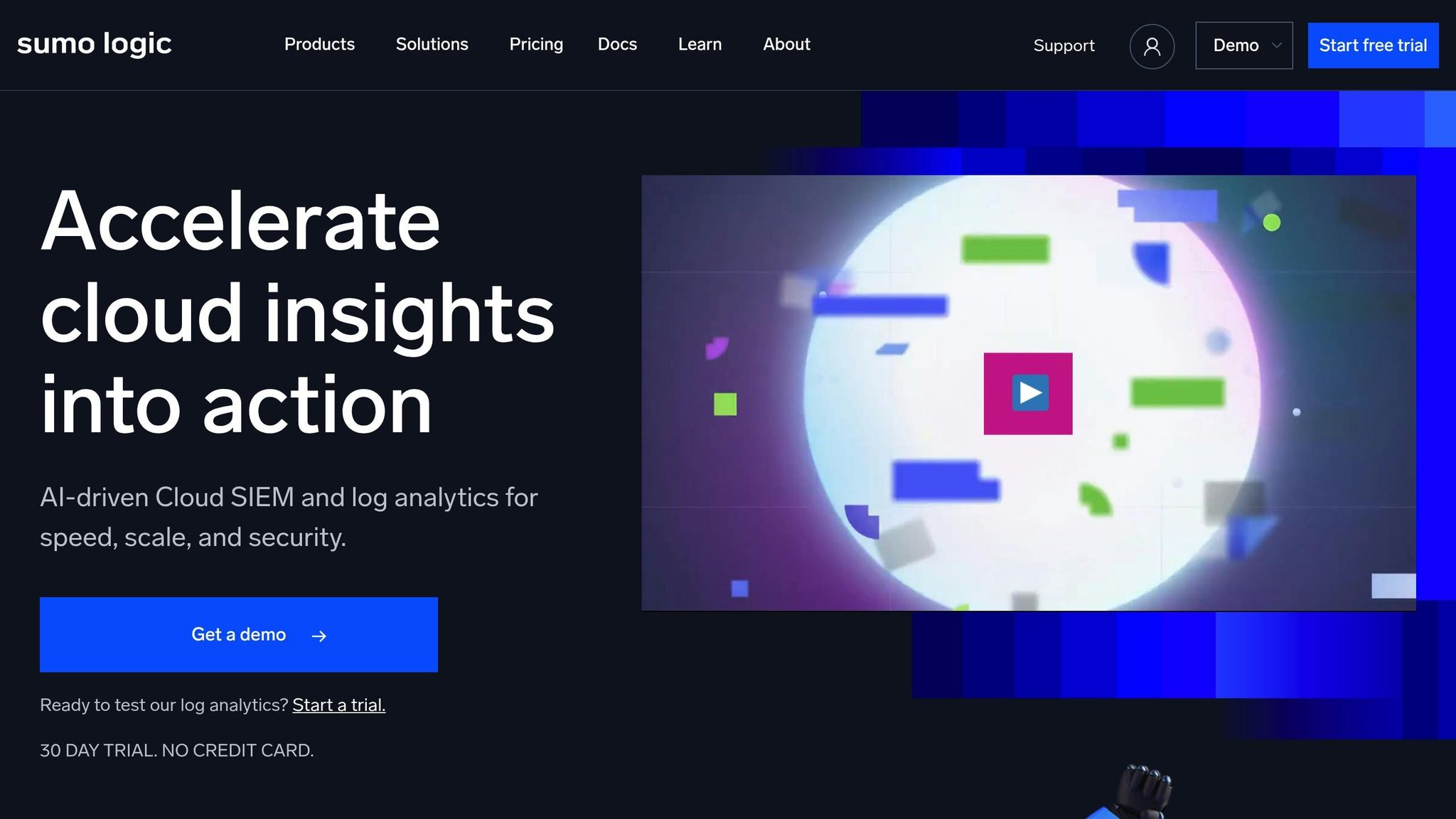
Sumo Logic Cloud SOAR is designed to automate critical security tasks like triage, investigation, and threat remediation within private cloud environments. By tackling the overwhelming volume of daily alerts, it equips security teams with the tools needed to respond effectively to incidents in complex private cloud setups.
Automation Capabilities for Incident Response
This platform streamlines the entire incident lifecycle with its R3 Rapid Response Playbook engine and a visual editor for creating conditional workflows. Key processes such as incident qualification, triage, threat hunting, analysis, containment, and remediation are automated, saving time and reducing manual effort [2]. Using machine learning, it distinguishes real threats from false positives, helping to alleviate alert fatigue [2].
Sumo Logic Cloud SOAR also offers customisable playbooks and leverages Supervised Active Intelligence to suggest appropriate responses [4]. It extends automation to Standard Operating Procedures (SOPs), allowing teams to define rules for processing incident data from sources like email, syslog, and integrated systems. Actions can be triggered automatically or manually, depending on the data received [3].
Compatibility with Private Cloud Environments
The platform supports various cloud setups - whether private, single, multi-cloud, or hybrid environments [4]. Its Automation Bridge, a Linux-based virtual machine deployed on-site, ensures playbook actions align with private cloud requirements [2]. This gives private cloud operators full control over their infrastructure while benefiting from automated security workflows. Acting as a unifying layer, the platform connects existing tools, streamlining activities across the Security Operations Centre and delivering actionable insights [2].
Integration with Existing Cloud-Native Tools
Sumo Logic Cloud SOAR’s Open Integration Framework allows seamless integration with a range of tools without requiring coding [2]. It works with major cybersecurity solutions like Palo Alto Networks, Cisco ThreatGrid, IBM QRadar, Splunk, and McAfee to synchronise security operations [2].
The platform also integrates with third-party threat intelligence providers, automating the investigation of Indicators of Compromise (IoCs) for both cyber and non-cyber scenarios. Teams can configure webhooks to send alerts from scheduled searches to Cloud SOAR using pre-set incident templates, creating a cohesive response system [3]. A real-world case study highlighted its ability to integrate smoothly with legacy systems, further reinforcing its value in unifying security operations [5].
Support for UK-Specific Data Residency and Compliance
Sumo Logic Cloud SOAR addresses the stringent data residency and compliance needs of UK organisations. Customers can choose an AWS Region for data storage, ensuring alignment with local data protection laws [8]. The company also operates Sumologic Limited, a UK-based entity that serves as a representative under Article 27 of UK GDPR [9].
Its Data Processing Addendum includes provisions for UK data transfers, ensuring compliance with UK GDPR [6]. Additionally, Sumo Logic holds certifications such as PCI, SOC2 Type 2, CSA, ISO, and HIPAA, making it a reliable choice for organisations with strict regulatory demands [7][8]. This combination of local data control and certifications makes it particularly well-suited for UK organisations managing private cloud infrastructures.
2. Wiz Cloud Investigation and Response Automation (CIRA)
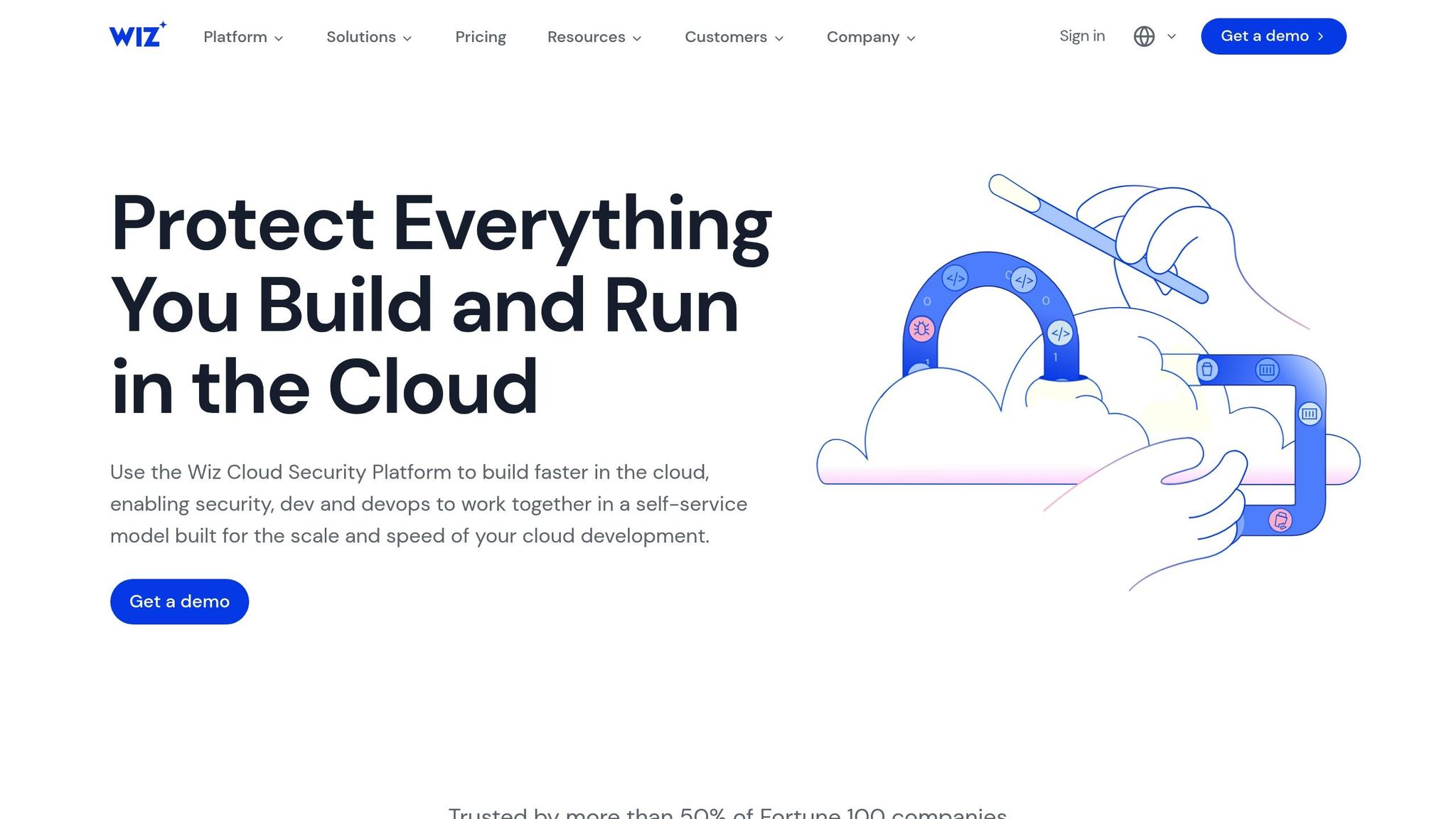
Wiz Cloud Investigation and Response Automation (CIRA) is a platform designed to simplify and accelerate forensic data collection and analysis in cloud environments. By using advanced machine learning, it enhances incident response workflows, making it particularly effective for private cloud setups where speed and precision are critical.
Automation Capabilities for Incident Response
CIRA employs machine learning and AI to automate forensic investigations, analysing logs and metrics to identify anomalies and potential security threats. This significantly cuts down the time needed for investigations [11].
CIRA technologies are designed to automate the collection and analysis of forensic data in cloud environments, which expedites response times to cybersecurity incidents.- Stream Security [10]
The platform’s threat intelligence feature cross-references anomalies with known threat patterns to detect security incidents in real time. Once a threat is flagged, CIRA can act swiftly by initiating predefined response protocols. Its library of automated playbooks can handle tasks like isolating affected resources, rolling back changes, revoking compromised credentials, and blocking malicious IPs. These playbooks are fully customisable to fit the specific needs of an organisation’s infrastructure [11].
Wiz Defend, a key component of the platform, offers automated containment and response workflows tailored for cloud incidents. It includes one-click containment options and supports custom response actions written in Python for more complex scenarios [1][12]. This approach reduces the mean time to identify (MTTI) and contain (MTTC) incidents by up to 33% [1].
These automation capabilities are seamlessly adaptable across private cloud environments.
Compatibility with Private Cloud Environments
CIRA’s flexibility allows it to connect with any cloud environment. It uses a hybrid detection model that combines agentless telemetry with optional runtime sensors, ensuring comprehensive visibility. This setup fosters collaboration among SecOps, Cloud Security, and Development teams [13][15][12]. The platform also integrates code-to-cloud context by leveraging CSP telemetry, real-time threat intelligence, and eBPF sensor runtime signals [12].
Integration with Existing Cloud-Native Tools
CIRA doesn’t just stop at automation; it enhances overall security operations by integrating with a wide range of tools. With over 100 integrations across categories like SIEM, SOAR, Threat Detection, and Vulnerability Management, it streamlines incident response workflows and strengthens security infrastructure [13][14][15].
Using APIs and automation tools, CIRA extends cloud-native capabilities, enabling responsive actions. Wiz Defend works in tandem with existing SIEM and SOAR tools, coordinating automation workflows and telemetry collection [1]. This integration reduces false positives and alert fatigue, allowing security teams to focus on high-priority threats.
Support for UK-Specific Data Residency and Compliance
Wiz CIRA is particularly suited for UK organisations, addressing local compliance requirements and data residency laws [16]. It helps map and resolve non-compliance issues through continuous compliance reporting for frameworks like NIST, CIS, and ISO, among others, using the Wiz compliance heatmap [16].
Post-Brexit, with the UK’s version of GDPR now in place, Wiz ensures workloads adhere to these regulations by automatically applying the necessary controls [17]. It also guarantees that data is hosted only in approved cloud regions, reducing the manual effort required to meet regulatory standards. This is especially valuable for private cloud environments, where maintaining compliance can otherwise be a complex and resource-intensive task [17].
3. Palo Alto Networks SOAR
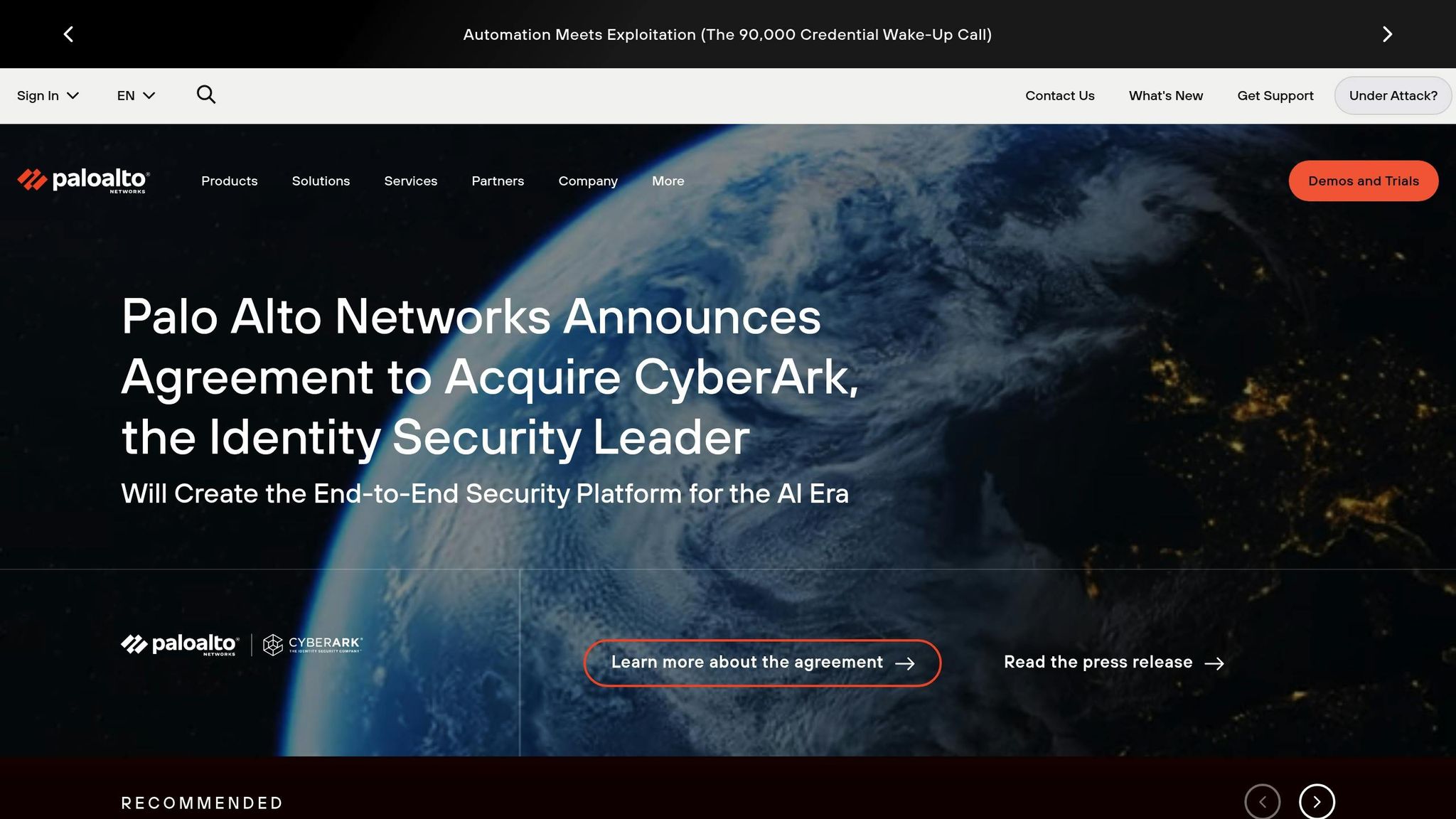
Palo Alto Networks SOAR, branded as Cortex XSOAR, offers a centralised platform for managing, executing, and automating security tasks. It brings together various teams and tools into a single interface, enabling security teams to respond faster to cyber threats while strengthening their overall defence capabilities. With its combination of advanced automation and flexible deployment options, Cortex XSOAR is well-suited for private cloud security setups [18].
Automation Capabilities for Incident Response
Cortex XSOAR takes on repetitive tasks and reduces alert fatigue by streamlining workflows. Its core capabilities include threat and vulnerability management, security incident response, and security operations automation [18].
The platform delivers measurable benefits, including up to 90% faster remediation, an 89% reduction in time spent on malware investigations, and a 75% decrease in manual incident handling. It can automate as much as 95% of actions that would typically need human intervention, cutting response times by up to 90% [19][20].
Cortex XSOAR allowed us to orchestrate all the activities we used to perform manually, resulting in the optimisation of all the processes.- Head of Cyber Security Prevention and Transformation, BNL [19]
Cortex XSOAR offers pre-built playbooks and a drag-and-drop interface for custom workflows. These playbooks consolidate data from tools like threat intelligence platforms, firewalls, intrusion detection systems, and SIEMs, providing a unified approach to incident response [18].
Compatibility with Private Cloud Environments
Cortex XSOAR is designed to integrate smoothly with private cloud environments, offering deployment options that include on-premises, private cloud, or fully hosted solutions. This flexibility allows organisations to tailor the platform to their specific infrastructure needs [20].
For private cloud setups, the virtual appliance (OVA file) can be downloaded directly from the Palo Alto Networks Support Portal. The deployment process involves uploading the appliance to the cloud, configuring it to match the architecture, and applying the necessary licences to unlock its full capabilities [21].
System Requirements Summary:
- Cortex XSOAR Server: 8-16 cores, 16-32 GB RAM, 500 GB-1 TB SSD storage
- Cortex XSOAR Engine: Similar specifications, compatible with macOS, Windows, and Linux [20]
Integration with Existing Cloud-Native Tools
One of Cortex XSOAR's standout features is its ability to integrate with a wide range of security, IT operations, and threat intelligence tools, regardless of vendor. This ensures comprehensive data collection and analysis across an organisation's entire security ecosystem [18].
The platform provides a single console for investigating and resolving incidents, significantly reducing both the mean time to detect (MTTD) and the mean time to respond (MTTR) [18]. It also enables seamless coordination between security and non-security tools, automating workflows or alerting agents to critical incidents when necessary, creating an interconnected security environment [18].
Support for UK-Specific Data Residency and Compliance
Cortex XSOAR also aligns with UK data residency requirements. Palo Alto Networks offers a UK-based cloud location, allowing organisations to store data within UK borders while benefiting from direct access to services like Cortex XDR, Cortex Data Lake, and WildFire [25].
Our UK cloud location provides customers with global prevention, detection and response capabilities to counter increasingly sophisticated threats whilst addressing their data sovereignty and privacy needs.- Christian Hentschel, President of EMEA, Palo Alto Networks [25]
The platform simplifies compliance with local regulations, supporting certifications such as BSI C5, CSA Star 2, Data Protection Act, ISO 27001, ISO 27017, ISO 27018, ISO 27032, ISO 27701, NCSC Cloud Security Principles, SOC 2+, and TISAX [22].
Additionally, Cortex Cloud DSPM enhances compliance by scanning and classifying data within a customer's cloud account, offering the visibility and control needed to meet regulatory standards [23][24].
4. IBM Security QRadar SOAR
IBM Security QRadar SOAR simplifies incident response in private cloud environments by offering real-time dynamic playbooks and intelligent automation. It turns the often chaotic process of responding to security incidents into an organised, repeatable workflow. These workflows evolve in real time, giving security teams both the guidance and automation they need to address threats efficiently while ensuring consistency across all response activities [26][27]. This structured approach lays the groundwork for the platform's advanced automation features.
Automation Capabilities for Incident Response
QRadar SOAR can reduce incident response times by up to 85%, as evidenced by real-world cases like Doosan Digital Innovation (DDI) and Askari Bank's use of automated playbooks [26][27][29]. By automating time-consuming tasks - such as threat enrichment and filtering out false positives - the platform allows analysts to focus on tackling genuine security threats [26].
Its Playbook Designer provides a user-friendly, low-code interface for creating customised workflows. This feature enables security teams to design and implement robust incident response processes without needing advanced coding skills. These automated playbooks handle tasks like correlation, enrichment, investigation, and prioritisation of cases, ensuring that critical incidents are addressed promptly [27][28].
Compatibility with Private Cloud Environments
QRadar SOAR integrates seamlessly with IBM QRadar SIEM, MaaS, and over 200 third-party tools, including endpoint detection and response systems, cloud platforms, and ticketing systems. This ensures organisations can enhance their automation capabilities without discarding existing tools [26]. The platform's dynamic playbooks are designed to adapt to private cloud environments, offering intelligent workflows that respond to real-time conditions. With in-app guidance and a low-code design, security teams of varying technical expertise can easily leverage these features [26].
Integration with Existing Cloud-Native Tools
QRadar SOAR brings together a variety of security tools under a single response framework, preserving existing investments while complementing previously deployed solutions. Its automated threat enrichment gathers contextual data from multiple sources, helping to prioritise real threats and cut through unnecessary noise. This integration creates smooth workflows between security tools and non-security systems, reducing the time it takes to detect and respond to threats while improving overall operational efficiency.
In addition to unifying tools, QRadar SOAR also addresses critical compliance needs specific to private cloud environments.
Support for UK-Specific Data Residency and Compliance
QRadar SOAR is designed to meet UK compliance requirements with features like its QRadar SOAR Breach Response. This tool simplifies data breach compliance, including adherence to data breach notification laws. The platform supports over 200 privacy regulations globally, with a particular focus on those affecting UK organisations, such as GDPR [30]. A global knowledge base, continuously updated by a dedicated team, ensures UK organisations stay aligned with the latest data protection standards [30].
Security teams can also incorporate privacy reporting into their incident response playbooks. With support for over 180 built-in privacy regulations, organisations can manage compliance requirements effectively without slowing down their response efforts [27].
5. Microsoft Sentinel (Private Cloud Deployments)
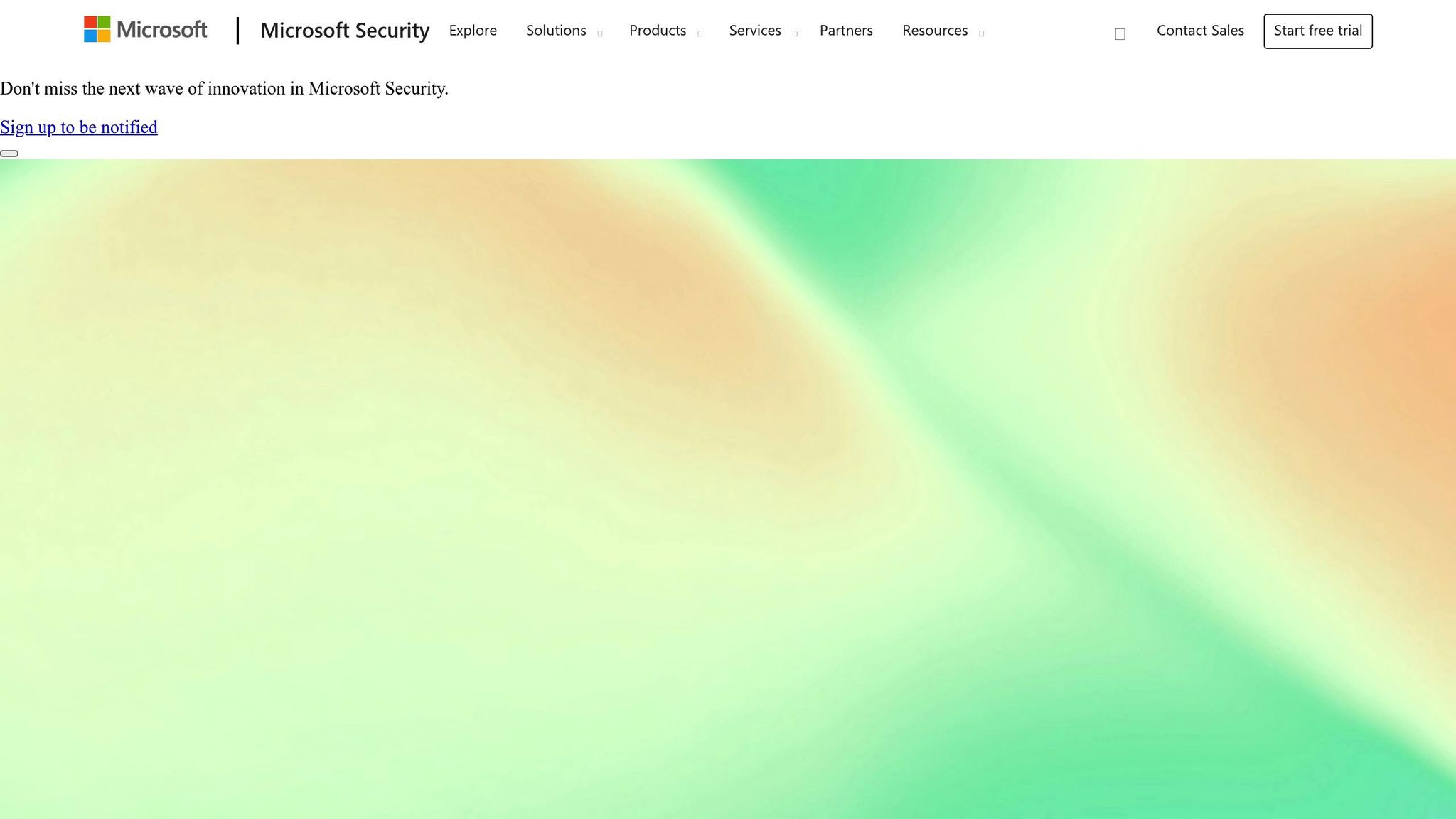
Microsoft Sentinel offers a robust solution for incident response in private cloud setups, combining cloud-native SIEM and SOAR capabilities with the ability to retain logs for up to 12 years to meet compliance standards [33]. In private cloud environments, it provides organisations with the scalability of cloud technology while ensuring they maintain control over their security infrastructure. This balance of long-term log retention and responsive automation makes it an appealing choice for private cloud security.
Automation Capabilities for Incident Response
Sentinel's automation features leverage intelligent playbooks and machine learning to streamline the process of identifying, investigating, and responding to threats. This reduces false positives and ensures that genuine risks are prioritised. By correlating events from multiple data sources, the platform creates detailed threat timelines, giving security teams a clear picture of potential incidents.
With Logic Apps integration, organisations can develop advanced workflows to interact with external systems, send alerts, and carry out remediation tasks. This automation significantly cuts down the mean time to response (MTTR) by handling routine tasks like data collection, initial threat analysis, and containment, freeing up security teams to focus on more complex issues.
Compatibility with Private Cloud Environments
Microsoft Sentinel fits seamlessly into private cloud setups, thanks to its flexible deployment options and hybrid connectivity features. It can ingest data from on-premises systems, private clouds, and hybrid environments, and supports distributed deployments across multiple regions. Using Kusto Query Language (KQL), Sentinel processes large volumes of security data, offering powerful analytics for diverse private cloud sources.
Its architecture enables organisations with geographically distributed private cloud infrastructures to maintain centralised visibility and control. This ensures consistent security monitoring and incident response, no matter the location. The platform’s ability to integrate with existing security tools further enhances its effectiveness in private cloud environments.
Integration with Existing Cloud-Native Tools
Sentinel integrates naturally with Microsoft's ecosystem, including tools like Azure Active Directory, Microsoft Defender, and Office 365 security solutions. Beyond that, it connects with third-party tools using pre-built connectors that support Common Event Format (CEF), Syslog, and REST API. This ensures a unified security view through customisable dashboards.
The workbooks feature allows security teams to create dashboards that consolidate data from multiple integrated tools, providing a single pane of glass for monitoring. This means organisations can continue using their existing tools while benefiting from Sentinel’s advanced analytics and automation capabilities.
Support for UK-Specific Data Residency and Compliance
Microsoft Sentinel addresses UK data residency requirements by storing raw data within the same region as the associated Azure Log Analytics workspace [31]. For UK organisations, this includes support for UK West Azure regions, ensuring compliance with data sovereignty rules [33].
The platform supports various UK compliance frameworks, such as DORA and FCA guidance for financial services, NIS2 compliance for critical infrastructure, and alignment with GDPR and the UK Data Protection Act through region-specific deployments [33]. However, it's important to note that Azure’s architecture may involve transferring data across data centres. To maintain compliance, UK organisations should deploy Sentinel in UK Azure regions and establish custom policies to control log ingestion.
According to correspondence between Scottish police and Microsoft, the latter cannot guarantee that UK police data stored in Azure environments stays within the UK, even though national legislation mandates this.[32]
For optimal compliance and efficiency, UK organisations should carefully define policies that determine which logs are ingested into the analytics tier versus the data lake tier [33]. This approach ensures that incident response activities remain effective while adhering to regulatory requirements.
Need help optimizing your cloud costs?
Get expert advice on how to reduce your cloud expenses without sacrificing performance.
Automation Methods for Private Cloud Incident Response
Handling incidents in private cloud environments demands swift, well-planned automation strategies. The fast-paced nature of cloud workloads means traditional manual responses often fall short, as incidents can escalate quickly and evidence can vanish just as fast. By building on earlier-discussed automated tools, organisations can create a more efficient and effective incident response framework.
Playbook-Driven Workflows for Consistent Responses
Playbook-driven workflows, sometimes referred to as runbooks, are essential for automating incident responses through predefined rules [1]. These workflows cover every stage of incident management - from detection to triage and resolution - ensuring no step is overlooked.
Security Orchestration, Automation, and Response (SOAR) tools are particularly effective in enabling automated triaging and remediation with minimal human input [1]. Success hinges on setting clear baselines, rules, and triggers tailored to a private cloud’s specific needs. For instance, in an AWS setup, a runbook addressing a compromised S3 bucket would guide actions like root cause analysis, sensitivity checks, and remediation steps such as blocking access, activating backups, and enforcing stricter authentication protocols [1].
A crucial aspect of these workflows is the immediate capture of forensic evidence. Automated playbooks should be designed to secure this information instantly, as the transient nature of cloud workloads can result in vital data disappearing quickly [1].
Real-Time Monitoring and Alerting Systems
Automated alert systems act as an early warning mechanism, identifying and notifying teams about potential security issues across cloud resources [34]. By consolidating security tools, logs, and telemetry, these systems provide comprehensive visibility into private cloud environments.
The effectiveness of automated monitoring depends on leveraging cloud-native tools with built-in automation. These tools can initiate rapid responses - like isolating compromised resources or revoking access credentials - without waiting for human intervention [34]. Such speed is critical in private clouds, where interconnected systems can amplify the impact of an incident.
IAM Integration for Precision and Control
When paired with playbook workflows and real-time alerts, Identity and Access Management (IAM) systems add another layer of security automation. By streamlining access controls, enforcing policies, and maintaining detailed audit trails, IAM integration strengthens incident response efforts [36].
Cloud-based IAM services are gaining traction, with over 80% of organisations expected to adopt them by 2025, delivering a 149% return on investment within three years [37]. These systems also enable faster identity integrations during mergers - 65% quicker than on-premises solutions [37]. Features like Multi-Factor Authentication (MFA) and Zero Trust principles ensure that every access request undergoes automated verification. When suspicious activity is flagged, IAM systems can revoke access, escalate alerts, and log details for forensic use. For example, a healthcare organisation using Avatier’s cloud IAM solution reported a 32% drop in identity management costs while expanding its capabilities [37].
Orchestration and Automated Remediation
Orchestration takes automation a step further by coordinating responses across multiple systems. SOAR tools are invaluable here, uniting security tools, processes, and teams into streamlined workflows [34]. These platforms can handle complex remediation tasks, including isolating threats, rotating credentials, and restoring services, all while avoiding delays caused by manual interventions.
Modern orchestration tools can also manage intricate decision trees, escalation protocols, and rollback scenarios automatically. For instance, SentinelOne protects endpoints, cloud workloads, and IoT devices. When action is required, it can isolate, quarantine, remediate, or even roll back the effects of potential threats [35].
While implementing these automation strategies requires thoughtful planning and rigorous testing, the benefits - such as reduced response times, consistent handling of incidents, and stronger security - make them indispensable for private cloud operations. These methods ensure private cloud environments remain both agile and secure.
Tool Comparison Table
When evaluating incident response tools for private clouds, it's essential to focus on features, automation capabilities, and compliance. The table below compares how various platforms address the distinct needs of private cloud security operations.
| Tool | Key Features | Automation Capabilities | Private Cloud Compatibility | UK Compliance Considerations |
|---|---|---|---|---|
| Sumo Logic Cloud SOAR | Real-time threat detection, unified dashboard, cloud-native design | AI-driven playbook execution, automated alert correlation, intelligent incident prioritisation | Excellent – designed specifically for cloud-first environments with API-based integrations | GDPR-compliant data handling; UK data residency options available |
| Wiz CIRA | Continuous security posture management, attack path analysis, runtime protection | Automated threat hunting, instant remediation workflows, contextual risk assessment | Outstanding – built for cloud workloads with agentless scanning | GDPR compliance; automated reporting aligned with UK regulations |
| Palo Alto Networks SOAR | Advanced threat intelligence, case management, forensic analysis | Sophisticated playbook automation, machine learning-enhanced detection, cross-platform orchestration | Very good – supports hybrid and private cloud deployments with extensive integrations | Comprehensive GDPR compliance framework; automated audit trails |
| IBM Security QRadar SOAR | Unified security operations, advanced analytics, threat correlation engine | Cognitive automation powered by Watson AI, adaptive response workflows, predictive threat analysis | Good – traditional enterprise focus with cloud adaptation modules | Strong compliance tools; UK-specific regulatory templates available |
| Microsoft Sentinel | Native Azure integration, hunting queries, visualisation workbooks | Logic Apps integration, automated investigation graphs, AI-powered analytics | Excellent for Azure-based private clouds; limited for multi-cloud setups | Built-in GDPR compliance tools; certified for UK government cloud use |
Key Insights on Automation and Compliance
These platforms demonstrate how automation and compliance features can significantly enhance efficiency and reduce costs in private cloud security. For instance, automation has been shown to cut Mean Time to Identify (MTTI) and Mean Time to Contain (MTTC) by 33% [1]. This translates to notable time savings, reducing incident resolution durations from approximately 4 hours to just 2 hours and 40 minutes, even as IT incidents surged by 48% over the past year [38].
For UK organisations, GDPR compliance automation is particularly vital. Tools like Wiz CIRA and Microsoft Sentinel streamline compliance through automated reporting and data residency controls, minimising manual effort while ensuring consistent policy enforcement across cloud workloads.
In private cloud environments, the shared responsibility model requires automation to go beyond basic alerting. Effective tools must support evidence collection, forensic data preservation, and coordinated remediation across multiple system layers [1]. Integration with orchestration platforms adds further value, enabling actions like revoking compromised credentials during incident response [34].
Balancing Cost and Efficiency
Cost efficiency is a critical consideration for private cloud security. Automation not only improves response times but also reduces overall costs. Some platforms offer transparent pricing, with endpoint costs ranging from £7 to £9 per month. Meanwhile, enterprise platforms often require custom quotes [39]. When assessing total cost of ownership, factors like integration complexity, training needs, and potential savings - estimated at around £10.8 million annually through effective automation - should be taken into account [38].
Hokstad Consulting's Role in Private Cloud Incident Response Optimisation
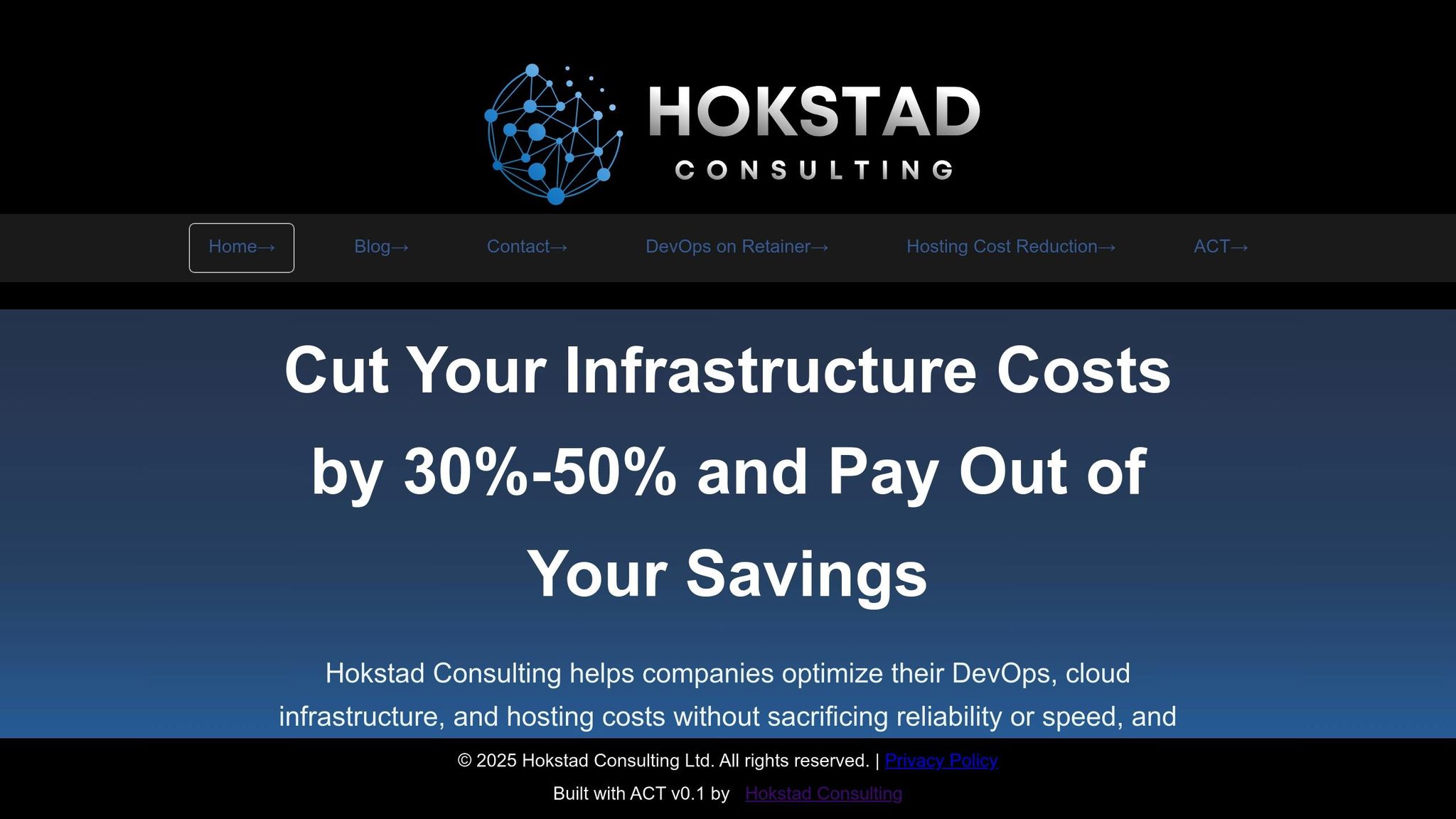
When it comes to private cloud incident response, cookie-cutter solutions rarely meet the mark. Hokstad Consulting steps in to bridge the gap, offering UK organisations tailored automation, custom development, and in-depth security audits that address their unique needs.
Tailored Automation for Private Cloud Environments
Hokstad Consulting doesn’t just implement standard automation playbooks - they take it a step further. Their DevOps transformation services integrate automated CI/CD pipelines with security monitoring tools, creating a seamless response framework tailored to your organisation’s infrastructure. This approach not only improves deployment cycles but can also cut cloud costs by 30-50%.
Their team develops custom workflows that connect your existing private cloud tools with incident response platforms. Whether you operate in hybrid environments, rely on managed hosting, or run fully private cloud setups, Hokstad Consulting ensures that your tools work harmoniously. These bespoke automation solutions lay a strong foundation for improving your organisation’s security operations.
Custom Development for Enhanced Security Operations
Hokstad Consulting addresses specific security challenges by developing specialised modules and integrations.
Their development team creates custom connectors to ensure seamless communication between your security tools. For example, they can build AI-powered agents that correlate security events across multiple layers of your cloud infrastructure, offering valuable insights that off-the-shelf tools often overlook.
For organisations navigating strict regulatory requirements, Hokstad Consulting also develops compliance-focused modules. These automated tools help maintain alignment with GDPR, healthcare data regulations, or financial services standards, streamlining reporting and ensuring continuous compliance.
This combination of tailored development and automation strengthens your security operations, while comprehensive audits help refine your overall strategy.
Comprehensive Security Audits and Strategy Development
Understanding your current security landscape is the cornerstone of effective incident response. Hokstad Consulting conducts detailed cloud security audits to identify vulnerabilities and assess your private cloud environment.
These audits go beyond basic vulnerability scans. The team evaluates your entire incident response process, from detection to recovery, ensuring that your tools and workflows integrate effectively. They identify gaps in automation, recommend improvements, and align their strategies with your operational needs.
The audit process also includes policy design and implementation, covering critical areas like data protection, access control, and incident response procedures. This ensures that technical, administrative, and physical security measures work together seamlessly.
Flexible Engagement Models for Ongoing Support
Hokstad Consulting offers a range of engagement options to suit different organisational needs:
- Retainer model: Provides ongoing support for infrastructure and cloud management, including regular security audits and performance tuning. This ensures your incident response systems evolve alongside your infrastructure.
-
No Savings, No Fee
model: Ties consulting costs directly to the savings achieved through improved automation and reduced response times. It’s a performance-driven approach that delivers measurable results. - On-demand DevOps support: Offers flexible, short-term expertise for implementing new tools, managing complex security events, or planning infrastructure changes that impact your security posture.
These flexible models allow organisations to access Hokstad Consulting’s expertise on their terms.
Integration with Modern Cloud Technologies
Hokstad Consulting’s work with AI-driven strategies and agents adds a cutting-edge dimension to incident response. Their intelligent automation adapts to your organisation’s incident patterns, enhancing accuracy and reducing false positives over time.
They also ensure that security remains a priority during strategic cloud migrations, maintaining incident response capabilities with zero downtime during transitions.
Additionally, their expertise in advanced caching and load offloading solutions improves overall system performance. By minimising resource contention, they create stable environments where security tools can function more effectively, ensuring consistent protection across your infrastructure.
Conclusion
Choosing the right incident response tools and automation strategies for private cloud environments demands a security framework tailored to your organisation's needs. With 76% of enterprises relying on private clouds for at least some workloads [41], making the right decision has never been more critical.
The tools we've discussed - ranging from Sumo Logic Cloud SOAR to Microsoft Sentinel - each bring distinct strengths to the table. However, the key lies in aligning these tools with your organisation's specific compliance and operational requirements. As Wiz aptly highlights:
Organizations can no longer afford to respond to incidents after the fact. IR must become part of organizations' cybersecurity risk management strategy.- Wiz [40]
This proactive approach is especially crucial when you consider that 65 to 70% of cloud security breaches stem from misconfiguration [43]. By addressing vulnerabilities before they escalate, organisations can significantly reduce risks.
Compliance should be a guiding factor in your decision-making process. Private clouds can meet stringent regulatory standards, but only if paired with the right incident response tools. Evaluating these tools under practical, real-world conditions ensures they not only meet compliance needs but also strengthen your overall security posture. Beyond automation, their effectiveness hinges on seamless integration with your existing systems. Ask yourself: Can these tools manage your data encryption requirements? Do they integrate with your current access controls? Will they provide the forensic data necessary to understand and respond to incidents effectively? As Ariel Parnes explains:
When it comes to responding to an incident, the first thing that you need to do is understand what happened or what is happening, where it is happening, when - so you can make your decisions with regards to containment, to remediation, etc. In order to understand what happens, you need to have the forensic data, the telemetry, the logs, so that they can look and extract the story.- Ariel Parnes [42]
While technology plays a crucial role, the human element remains indispensable. Even the most advanced automation won't deliver results if your team can't use it effectively. Conduct thorough risk assessments, test tools rigorously, and ensure your team is well-trained. Regular monitoring and audits are vital to identifying and closing gaps early. The ultimate goal is to implement incident response capabilities that are not only efficient but also seamlessly integrated into your organisation's infrastructure.
FAQs
How does automation improve incident response in private cloud environments, and how does it help reduce costs while ensuring better service uptime?
Automation plays a key role in improving incident response within private cloud environments. By automating repetitive tasks and speeding up reaction times, businesses can address issues more efficiently, cutting down operational costs and reducing the reliance on manual efforts.
It also boosts service availability by enabling quicker detection and containment of incidents. This not only minimises downtime but also enhances system reliability and reduces recovery costs, ensuring a smoother and more efficient cloud operation.
What UK compliance standards do incident response tools address in private cloud environments, and why are they important?
Incident Response Tools in Private Cloud Environments
When it comes to private cloud environments, incident response tools must align with key UK compliance standards. These include ISO 27017, GDPR, NCSC guidelines, and sector-specific regulations like DSPT for healthcare and JSP 440 for defence. Each of these frameworks plays a vital role in ensuring the secure management of sensitive data, robust protection against threats, and adherence to legal obligations.
Meeting these compliance standards isn't just a box-ticking exercise. It’s essential for maintaining client trust, avoiding hefty regulatory fines, and protecting private cloud systems from breaches or vulnerabilities. Beyond that, it signals a dedication to strong data security policies and operational resilience, which are critical in today’s digital landscape.
What steps can organisations take to seamlessly integrate incident response tools into their private cloud infrastructure?
Integrating Incident Response Tools with Private Cloud Infrastructure
When it comes to integrating incident response tools within private cloud environments, two factors stand out: automation and customisation. Automating processes like threat detection and response not only simplifies operations but also speeds up reaction times. Meanwhile, tailoring response plans to fit the distributed nature of private clouds ensures everything runs smoothly and efficiently.
Using frameworks such as NIST SP 800-61 Rev can provide a solid foundation by aligning your processes with recognised industry standards. Adding threat intelligence feeds into the mix can further sharpen detection capabilities, making it easier to identify potential risks. And let’s not forget the human element - regular training for your team is key to ensuring they’re equipped to handle incidents confidently.
Finally, continuous monitoring and routine testing of your tools are critical. These practices help maintain a strong and reliable incident response strategy that can adapt to evolving challenges.
